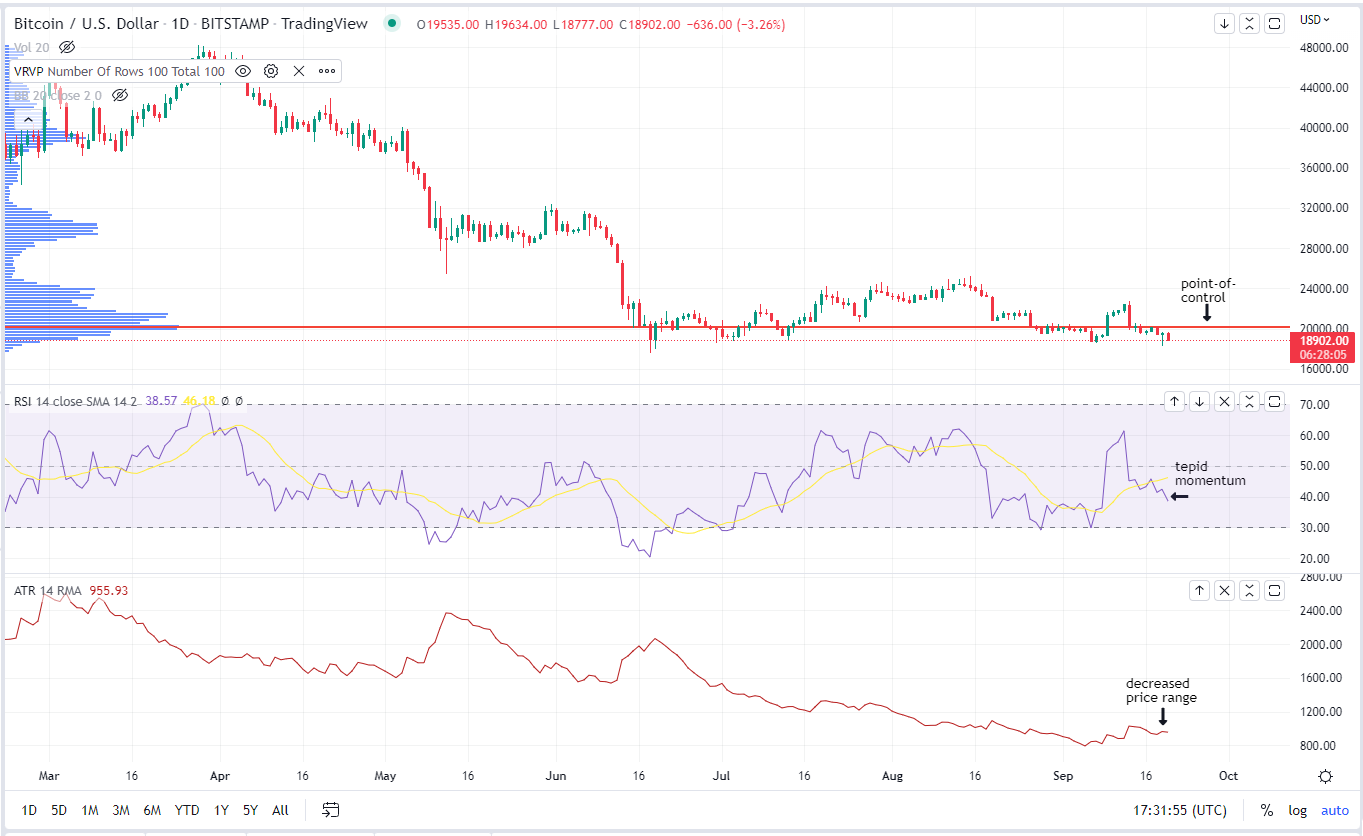Price Action
Bitcoin and ether are down Tuesday ahead of Wednesday’s Federal Open Market Committee (FOMC) interest rate decision.
-
Bitcoin (BTC) declined 2.5% on moderate volume, when compared to its 20-day moving average for volume. BTC’s hourly chart shows a steady decline that began in overnight trading and was punctuated by high volume during the 13:00 UTC (9:00 a.m. ET) hour. The timing of the spike in volume during the downturn coincided with the opening of U.S. equity markets, and could signal a risk-off approach ahead of the Federal Reserve committee’s announcement at the end of its two-day meeting Wednesday.
-
Ether (ETH) fell 1.6%, the sixth day of declines in the last 10 days. For those keeping score, ether prices are down 18% since the Sept. 15 Ethereum Merge and down 63.5% for the year to date. The supply of ether has increased 3,700 post-Merge but the rise has not been deflationary. Absent the Merge, however, it is estimated that ETH’s supply would have increased by 66,000 ETH over the same period.
The CoinDesk Market Index (CMI), a broad-based market index that measures performance across a basket of cryptocurrencies, declined 2.5%
Economic Calendar: Investors and other observers of the U.S. economy await the Federal Reserve’s rate decision Wednesday.
Market Wrap is using the CME Group FedWatch tool as a proxy for rate expectations. The tool uses CME Group Fed Funds Futures contracts to determine probabilities for rate hikes. Currently, the CME tool is predicting an 84% probability of a 75 basis point (BPS) hike, and a 16% probability of a 100 BPS move. A 100 BPS, or 1%, increase would be the highest in four decades.
Any hike will mark the fifth consecutive rate increase by the Fed’s rate-setting committee, the FOMC. Prior rate hikes occurred on:
-
July 28 – 75 basis points
-
June 16 – 75 basis points
-
May 5 – 50 basis points
-
March 17 – 25 basis points
BTC returns for the 30 days following each rate hike were: -3%, -18%, 3.9% and -18%, respectively.
U.S. Equities: Traditional equities declined, with the Dow Jones Industrial Average (DJIA), tech-heavy Nasdaq composite and S&P 500 falling by 1%, 0.95% and 1.1%, respectively.
Commodities: WTI crude oil declined 1.3% while natural gas fell 0.6%. Copper futures, often used as a measure for overall economic health fell 0.31%, while gold prices declined 0.26%.
The Dollar Index (DXY) increased slightly, rising 0.5%.
Latest Prices
● Bitcoin (BTC): $18,953 −3.0%
● Ether (ETH): $1,343 −1.5%
● CoinDesk Market Index (CMI): $948 −1.3%
● S&P 500 daily close: 3,855.93 −1.1%
● Gold: $1,673 per troy ounce +0.4%
● Ten-year Treasury yield daily close: 3.57% +0.08
Bitcoin, ether and gold prices are taken at approximately 4pm New York time. Bitcoin is the CoinDesk Bitcoin Price Index (XBX); Ether is the CoinDesk Ether Price Index (ETX); Gold is the COMEX spot price. Information about CoinDesk Indices can be found at coindesk.com/indices.
Technical Take
BTC Prices Appear Poised to Trade Around ‘Point of Control’
Bitcoin is trading in a tight range and appears positioned to continue that way. As mentioned in Monday’s Market Wrap, bitcoin is suffering from a lack of strong catalysts. What few there are include what the market expects from the Fed on interest rate policy and the extent to which the central bank surprises markets.
The Fed is unlikely to announce anything surprising on the interest rate front. Investors will likely be paying more attention to Fed Chair Jerome Powell’s comments once the FOMC meeting ends because the rate decision has largely been telegraphed for weeks.
If Powell expresses optimism about the state of U.S. inflation, bitcoin’s price will likely move higher. Absent that, all signs point to a situation where the price takes a step back for every step forward.

Bitcoin/U.S. dollar daily chart along with RSI and ATR metrics (Glenn Williams Jr./TradingView)
Technically, BTC is trading below its “point of control” in relation to the Volume Profile Visible Range tool (VPVR). VPVR illustrates trading volume by price level. The point of control, denoted by the red line in today’s chart, signals where the largest amount of activity occurred, and represents an area of high agreement in price.
When an asset trades above its point of control, it implies an area of support because investors are typically willing to step in and buy at this price level. When an asset trades below its point of control, it represents an area of resistance, or the point where investors have historically been willing to sell.
It can also represent opportunity if the current price falls far enough below the POC. BTC’s current price is 7% below its POC, which may not present a compelling enough opportunity to lure significant buying pressure.
Bitcoin’s Average True Range (ATR), which measures the average trading range of an asset over a period, is now 5% of BTC’s current value, less than the 7% spread between price and the POC. Price momentum also appears to signal mild price action because BTC’s Relative Strength Index (RSI) reading of 38 implies the crypto is fairly valued at the moment.
The RSI indicator measures price momentum and signals whether an asset is potentially overbought (readings over 70) or oversold (readings below 30). Its current reading is likely to approach an oversold area on further downturns but has not reached that mark yet.
All told, a compressed price range, high price agreement and tepid momentum don’t foreshadow sharp price moves up or down for bitcoin any time soon.
Altcoin Roundup
-
XRP, Ether Lead Recovery in Crypto Majors as Markets Prepare for Outsized Fed Hike: The rise in XRP came as token issuer Ripple Labs said in a filing to the U.S. Securities and Exchange Commission that XRP wasn’t a security subject to the regulator’s authority. The U.S. central bank is expected to again hike rates by 75 basis points on Wednesday. Read more here.
-
Cosmos’ ATOM Gains, Bucks Post-Merge Lull on Outlook for New Uses, Better Security: Cosmos is likely to announce the interchain security feature next week, opening doors for the token to capture value from the entire network. Read more here.
Trending Posts
-
Listen 🎧:Today’s “CoinDesk Markets Daily” podcast discusses the latest market movements and a look at the advantage of slowness and why it’s worth protecting.
-
Crypto Market Maker Wintermute Hacked for $160M, OTC Services Unaffected:Wintermute’s lending and over-the-counter operations have not been affected despite the hack.
-
Nasdaq Starts Crypto Custody Service for Institutional Clients:The exchange said it is open to working with crypto-native firms.
-
SoftBank, Deutsche Telekom Back $300M Fund With Web3 Component:The fund from DTCP launched in March and is still raising money. It is expected to close in 2023.
-
Colorado Residents Can Now Use Crypto to Pay Taxes:The state’s taxpayers can do so through PayPal for an additional fee.
-
Hong Kong Monetary Authority to Begin CBDC Trials in Q4, South China Morning Post Reports:The city’s de facto central bank will look at use cases and design issues related to a digital currency.
CoinDesk Market Index
Biggest Gainers
| Asset | Ticker | Returns | DACS Sector |
|---|---|---|---|
| XRP | XRP | +6.06% | Currency |
| Stellar | XLM | +5.64% | Currency |
| Render Token | RNDR | +5.2% | Computing |
Biggest Losers
| Asset | Ticker | Returns | DACS Sector |
|---|---|---|---|
| Cosmos | ATOM | -10.16% | Smart Contract Platform |
| Rarible | RARI | -8.66% | Culture & Entertainment |
| Ravencoin | RVN | -8.09% | Currency |
Sector classifications are provided via the Digital Asset Classification Standard (DACS), developed by CoinDesk Indices to provide a reliable, comprehensive and standardized classification system for digital assets. The CoinDesk Market Index (CMI) is a broad-based index designed to measure the market capitalization weighted performance of the digital asset market subject to minimum trading and exchange eligibility requirements.







